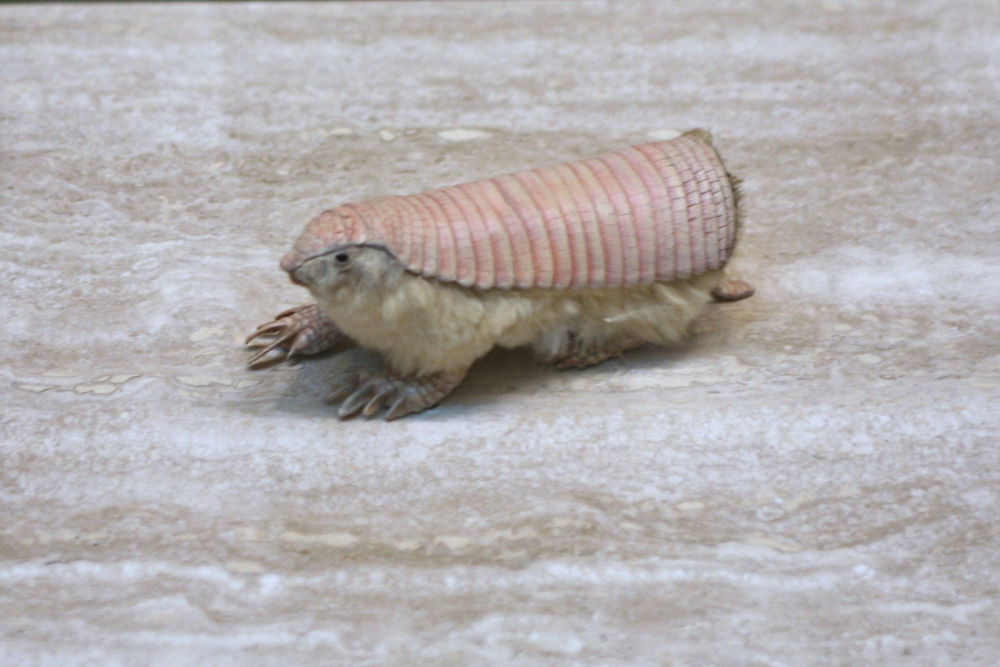In the vast and diverse tapestry of Earth’s wildlife, certain creatures stand out not only for their uniqueness but also for their ability to evoke wonder and curiosity. Among these marvels is the Pink Fairy Armadillo (Chlamyphorus truncatus), a diminutive yet captivating mammal that inhabits the sandy plains and grasslands of central Argentina. In this comprehensive exploration, we embark on a journey to uncover the secrets of the Pink Fairy Armadillo, shedding light on its distinctive characteristics, behaviors, and the challenges it faces in the modern world.
Appearance and Adaptations
The Pink Fairy Armadillo, often hailed as one of the world’s smallest armadillo species, measures a mere 3.5 to 4.5 inches in length, with its delicate pink shell resembling a miniature rose-tinted gem. This striking hue, which gives the armadillo its name, is attributed to the presence of blood vessels near the surface of its translucent carapace, allowing the rosy glow of its skin to shine through.
Adapted for life in the sandy soils of its native habitat, the Pink Fairy Armadillo boasts a unique suite of physiological and behavioral adaptations. Its compact, torpedo-shaped body is encased in a flexible shell composed of overlapping bony plates covered by a layer of keratin, providing protection against predators and the harsh elements of its arid environment. Additionally, the armadillo’s specialized front claws enable it to excavate burrows with remarkable efficiency, allowing it to escape the scorching heat of the day and forage for food beneath the surface.
Behavior and Diet
Despite its diminutive size and cryptic nature, researchers have gleaned insights into the behavior and diet of the Pink Fairy Armadillo through meticulous observation and study. Primarily nocturnal and fossorial, the armadillo spends much of its time burrowing in search of its preferred diet of insects, including ants, termites, and other small invertebrates. Using its keen sense of smell, it detects the presence of prey beneath the sandy substrate, employing its powerful front claws to excavate tunnels and unearth its meal.
In addition to its insectivorous diet, the Pink Fairy Armadillo supplements its nutrition with plant matter, including roots and tubers, found in the sandy soils of its habitat. This dietary flexibility allows it to adapt to fluctuations in food availability and ensures its survival in the harsh and unpredictable conditions of the Argentine grasslands.

Reproduction and Life Cycle
The reproductive biology of the Pink Fairy Armadillo remains relatively understudied, owing to the challenges of observing and studying these elusive creatures in their natural habitat. However, researchers believe that, like other armadillo species, it gives birth to a single offspring after a gestation period of around 60 to 75 days. The young armadillo, born blind and hairless, relies on its mother for protection and nourishment until it matures and ventures out on its own.
Conservation Status and Threats
Despite its enchanting allure, the Pink Fairy Armadillo faces numerous threats to its survival, primarily due to habitat loss and degradation caused by human activities such as agriculture, urbanization, and mining. The conversion of grasslands into farmland and the construction of roads and infrastructure fragment the armadillo’s habitat, disrupting its natural behaviors and reducing its access to food and shelter.
Additionally, the Pink Fairy Armadillo is vulnerable to predation by domestic dogs and cats, as well as accidental deaths from vehicles on roads that traverse its habitat. Climate change poses further challenges, exacerbating the frequency and intensity of droughts and heatwaves in the region, which can have detrimental effects on the armadillo’s physiology and reproductive success.
Conservation Efforts and Future Outlook
Efforts to conserve the Pink Fairy Armadillo and its habitat are crucial for ensuring the long-term survival of this unique and charismatic species. Conservation initiatives focus on habitat preservation, including the establishment of protected areas and corridors to facilitate movement between fragmented habitats. Public awareness and education campaigns raise awareness about the plight of the Pink Fairy Armadillo and the importance of preserving the biodiversity of Argentina’s grasslands for future generations.
In conclusion, the Pink Fairy Armadillo serves as a poignant reminder of the fragility of life on Earth and the urgent need to protect and preserve our planet’s natural heritage. By working together to address the threats facing this remarkable creature, we can ensure that it continues to enchant and inspire for generations to come, embodying the resilience and beauty of the natural world.









